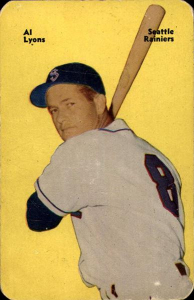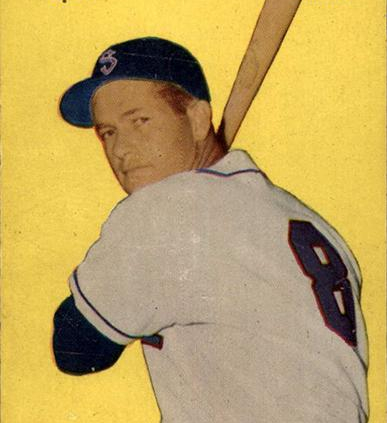Al Lyons
 Al Lyons was a pitcher during parts of four seasons in the Major Leagues, a slugging outfielder and ace pitcher in the Pacific Coast League, and a Mets scout later in life. Albert Harold Lyons, Jr. was born on July 18, 1918, in St. Joseph, Missouri, to Albert Harold Lyons and Irene V. (Sears) Lyons. The family, including Al’s older brother Jack, later relocated to California, where Al played baseball at Washington High School in Los Angeles. He was also an All-Southern California fullback on the football team, but Al’s best sport was baseball, where he played for an American Legion team and a semipro squad in Los Angeles.
Al Lyons was a pitcher during parts of four seasons in the Major Leagues, a slugging outfielder and ace pitcher in the Pacific Coast League, and a Mets scout later in life. Albert Harold Lyons, Jr. was born on July 18, 1918, in St. Joseph, Missouri, to Albert Harold Lyons and Irene V. (Sears) Lyons. The family, including Al’s older brother Jack, later relocated to California, where Al played baseball at Washington High School in Los Angeles. He was also an All-Southern California fullback on the football team, but Al’s best sport was baseball, where he played for an American Legion team and a semipro squad in Los Angeles.
Lyons began his professional career in 1940, as an outfielder with the Joplin (Missouri) Miners, the New York Yankees affiliate in the Class C Western Association. The six-foot-two, 195-pound Lyons batted .299, with 13 home runs and 97 runs batted in. He returned to Joplin in 1941, batting.304 with 10 home runs, 83 RBIs, and 52 extra-base hits. And in his first season as a pitcher, he posted a 5-1 record, with an impressive 1.26 ERA, and 48 strikeouts in 43 innings pitched.
Joplin battled the Springfield Cardinals much of the season before catching fire in August. The Miners went on a tear, winning 30 of 41 games for the regular season title. Lyons moved up to the Binghamton (New York) Triplets of the Class A Eastern League in 1942, where he again played the outfield. He had thirty-two assists and participated in eleven double plays, while hitting .249 with eight home runs and 73 RBIs.
Lyons was elevated to the Kansas City Blues of the American Association, one of the Yankees’ two Class Triple-A (then called Double-A) teams in 1943. Lyons, who threw and batted right-handed, continued to showcase his talents as a pitcher and as an outfielder. Under manager Johnny Neun, he went 4-6 on the mound with a 3.49 ERA in eighty innings pitched, while batting .236 as a pitcher and in seventy-eight games as an outfielder.
As the 1944 season began, the draft called several Yankees’ pitchers into the military, including Butch Wensloff, Marius Russo, and Tommy Byrne. That opened up a pitching slot for Lyons, who appeared in eleven games that season. He made his Major League debut as a pinch-hitter for Monk Dubiel at Boston’s Fenway Park on April 19, 1944. Six days later Lyons made his pitching debut in relief of starter Tiny Bonham. He faced only nine batters in 1 2/3 innings but five of them had hits and three of them scored.
Lyons allowed twenty earned runs in 39 2/3 innings for the third-place Yankees, without recording a decision. He averaged five walks per nine innings, threw five wild pitches, committed two balks, and hit two batters. His season ended in early August when he had to report for duty with the U. S. Navy.
In late March 1945, Lyons participated in a spring training three-game series against the New York Giants at the Bainbridge Naval Training Center in Maryland. On the 25th, he held the Giants to a lone single over 4 1/3 innings and also belted a home run to help the Bainbridge Commodores to an 8-4 victory. Other navy men with Major League experience in the Bainbridge lineup included Dick Sisler, Stan Musial, and Eddie Miksis.
Lyons spent the entire 1945 season in the navy, but he made the Yankees’ Opening Day roster in 1946. On April 24 he was optioned to Kansas City, where he pitched in twenty-four games with a 7-12 record with a 3.67 ERA. Lyons was recalled by the Yankees in September and appeared in two games, losing his only decision. On September 24, Lyons made his only Major League start, a losing effort in a meaningless game against the pennant-winning Red Sox at Fenway Park.
During the 1947 season Lyons pitched in six games for the Yankees, winning one, on June 1 against Cleveland. It was his first Major League victory and his only decision of the year for the Yankees. As a hitter, he had four hits in six at-bats, with a double, and three runs batted in.
On August 3, 1947, the Pittsburgh Pirates purchased Lyons’ contract from the Yankees for the waiver price. He appeared in thirteen games down the stretch for the Pirates, with a 1-2 record over 28 1/3 innings. Lyons hit his only Major League home run on September 23, at Forbes Field, off St. Louis’s Jim Hearn. Meanwhile, the Yankees went on to win the pennant, while the Pirates finished in last place. Nonetheless, after New York went on to beat Brooklyn in the World Series, the Yankees voted Lyons $2,915—half a Series share.
On November 18, 1947, the Pirates traded Lyons, outfielder Jim Russell, and catcher Bill Salkeld to the Boston Braves for outfielder-first baseman Johnny Hopp and infielder Danny Murtaugh. When the 1948 season began, Lyons made only one appearance in the early going, April 24, pitching two-thirds of an inning and allowing three hits in a 16–9 home loss to the Giants. Three weeks later, on May 13, the Braves assigned Lyons to their Milwaukee farm team in the American Association, where he was 3-2 in eleven games.
The Braves recalled him on July 3, a move manager Billy Southworth felt would help energize his pitching staff. “Southworth thinks Lyons will become a 20-game winner,” the game notes in the July 3, 1948, issue of the Worcester Telegram stated. “It is Southworth’s opinion that Lyons was never allowed to concentrate on his pitching with the Yankees and Pirates.”
Lyons appeared in only two games with the Braves in July. On the 17th he went 2 1/3 innings, allowing two hits and two walks and striking out one in a 4–1 loss at Chicago. Three days later, he surrendered three hits and a walk in two-thirds of an inning against Cincinnati. On July 24, outfielder Jim Russell was hospitalized and the depleted Braves outfield needed some reserve help. Southworth used Lyons on occasion to fill one of the outfield spots and called upon him several times in pinch-hitting roles.
Lyons’ last appearance in a major league game occurred during the pennant-winning Braves’ final regular-season contest of 1948. Playing the Giants at the Polo Grounds, Southworth emptied his bench during an 11–1 rout of New York. Lyons played in center field and right field and was 0-for-2 with a walk. He rode the bench as the Braves bowed to the Cleveland Indians in the World Series, four games to two, but he did receive a half share of series money, worth $2,285.
Overall Lyons wound up his career with a 3-3 record as a pitcher and as a .293 lifetime hitter in fifty-eight at-bats. Shortly after the ’48 World Series, Lyons was traded by the Braves to the Seattle Rainiers of the Pacific Coast League
Lyons remained in the Pacific Coast League from 1949 until 1955, where he gained the reputation of being a power-hitting, strong-armed outfielder. He belted a total of seventy-six home runs with the Rainiers and had two stars painted on the center-field fence of Seals Stadium in San Francisco to signify two balls he hit over the 404-foot distant spot.
In 1949 Lyons led Seattle team with twenty-three home runs. The following season, he led the PCL in home runs with twenty-two, including one over the center-field fence, one of the longest blasts ever seen at Seattle’s Sick’s Stadium.
Lyons pitched in twelve games for Seattle in 1951, going 8-4 with a 2.78 ERA. The Rainiers won the Pacific Coast League championship under manager Rogers Hornsby, then captured the Governor’s Cup over the Hollywood Stars, three games to two.
At the end of the 1951 season, Lyons was part of a contingent of PCL stars that joined Lefty O’Doul’s entourage to play a series of exhibition games in Japan. The big leaguers in the group included Joe DiMaggio and Dom DiMaggio, Ferris Fain, Eddie Lopat, Bobby Shantz, Mel Parnell, and Billy Martin.
Playing in Shizuoka, Japan, on November 6, Lyons scattered seven hits against a Japanese team over eight innings and also hit a three-run homer to lead the U.S. All Stars to a 6–1 victory.
Following another season with the Rainiers, Lyons was traded to the San Francisco Seals in December 1952. After playing the 1953 season and the start of 1954 campaign with San Francisco, Lyons moved to the San Diego Padres. He returned to the mound for the 1954 season, appearing in twenty-one games with an 8-2 record and a 2.30 ERA.
Lyons began the 1955 season with San Diego, before moving on to play with Hollywood. He logged a combined 10-5 record, with a 5.81 ERA. That was his swan song in the PCL. Through his seven-year career in the league, from 1949 through 1955, he appeared in a total of 919 games, with a batting average of .263 and a pitching record of 26-12.
In 1956, Lyons became the player-manager of the Modesto Reds, a Yankees farm team in the Class C California League, but he was replaced as manager on July 26. Lyons ended the season batting .316 in sixty-three games and posted a 2-0 record in six pitching appearances.
Before the 1956 season ended, Lyons went on to play in the Man-Dak League, an independent league in Manitoba and North Dakota. Lyons’ final season of organized baseball came at the age of thirty-eight in 1957, when he played for the Brandon (Manitoba) Greys in the Man-Dak League. Lyons later became a scout for the New York Mets, where he was credited with signing pitcher Dick Selma in 1963 and pitcher Don Shaw in 1965. Lyons remained a Mets scout until his early death of a heart attack at age forty-seven in Inglewood, California, on December 20, 1965. He is buried in Inglewood Park Cemetery. Lyons was survived by his wife Margaret Louise (Runions) Lyons, and his son Albert.
This biography is included in the book “Bridging Two Dynasties: The 1947 New York Yankees” (University of Nebraska Press, 2013), edited by Lyle Spatz. For more information, or to purchase the book from University of Nebraska Press, click here. A different version of this biography originally appeared in the book “Spahn, Sain, and Teddy Ballgame: Boston’s (almost) Perfect Baseball Summer of 1948,” edited by Bill Nowlin and published by Rounder Books in 2008.
Sources
Phillips, John. The Story of Al Lyons, Kathleen, Georgia: Capital Publishing Co., 2006.
Milwaukee Brewers Media Guide, 1948.
Worcester Telegram: Game coverage for 1948 season.
Full Name
Albert Harold Lyons
Born
July 18, 1918 at St. Joseph, MO (USA)
Died
December 20, 1965 at Inglewood, CA (USA)
If you can help us improve this player’s biography, contact us.


